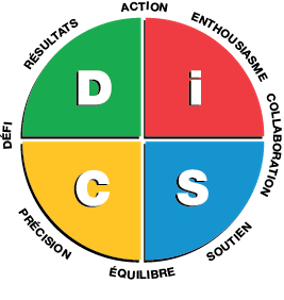What is DiSC?
The DiSC model is a personality assessment tool that classifies human behaviors into four main domains: Dominant (D), Influential (i), Steady (S), and Conscientious (C). Each of these categories reflects a distinct behavioral style, based on how a person perceives and interacts with their environment. The DiSC model is based on two main axes: a vertical axis that situates us between action and balance, and a horizontal axis that places our preference between challenge and collaboration.

The Four DiSC Personality Types
Dominant (D)
Key Traits: Dominant type people are energetic, ambitious, and results-oriented. They are often seen as assertive, competitive, and willing to take on challenges. They have a strong drive to succeed and make decisions quickly.
Typical Behaviors: Dominant individuals prefer to take initiative and responsibility, enjoy managing and leading projects, and often opt for quick and effective actions. They do not hesitate to express their opinions and take risks to achieve their goals.
Motivations: Personal achievement, control, power and tangible results.
Potential Weaknesses: Tendency to be impatient, bossy, and insensitive to the needs of others.
Influential (I)
Key Traits: Influential people are outgoing, enthusiastic, and persuasive. They thrive on social interaction and enjoy working in a team. Often charismatic and optimistic, they inspire and encourage others.
Typical Behaviors: Influential people love to be the center of attention, organize meetings and social events, and are often very expressive. They are effective at motivating others and generating enthusiasm around projects or ideas.
Motivations: Social recognition, influence, positive relationships and dynamic environment.
Potential Weaknesses: Tendency to be disorganized, lack detailed follow-through, and overly optimistic.
Stable (S)
Main characteristics: Steady people are patient, loyal and cooperative. They prefer a harmonious and predictable environment and are often resistant to change. They are reliable and maintain a constant work pace.
Typical Behaviors: Steady individuals work methodically, are good listeners, and provide consistent support to their coworkers. They avoid conflict and seek harmony in their professional and personal relationships.
Motivations: Security, stability, cooperation and a peaceful environment.
Potential weaknesses: Tendency to be resistant to change, avoid confrontation and lack proactivity.
Conscientious (C)
Key Characteristics: Conscientious individuals are analytical, precise, and detail-oriented. They value quality, rigor, and structure. They prefer an orderly environment where rules and procedures are followed.
Typical Behaviors: Conscientious people enjoy analyzing data, focus on details, and ensure high-quality work. They are rigorous in their approach and make decisions based on facts and evidence.
Motivations: Accuracy, excellence, structure and adherence to high standards.
Potential weaknesses: Tendency to be overly critical, perfectionist and have difficulty delegating.
Conclusion
The DISC model is a powerful and flexible tool that helps understand individual behaviors and improve interpersonal interactions. Whether in the professional, educational or personal context, it offers valuable insights to promote a better understanding of oneself and others, thus facilitating more harmonious and effective relationships.



